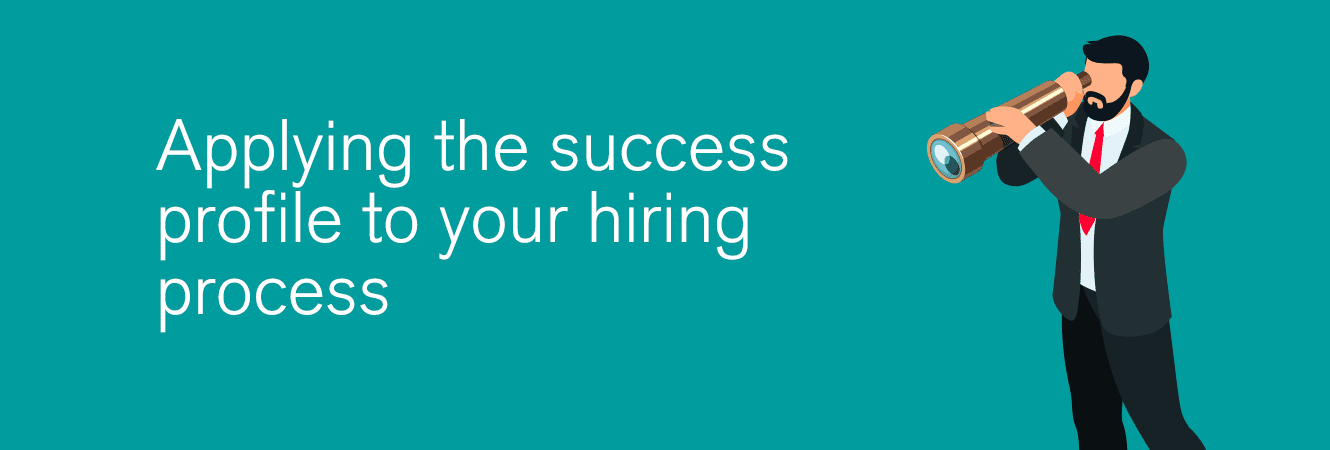Assessment: Make better hiring decisions with success profiling

How success profiling can help you make better hiring decisions
Any manager who has ever hired someone who didn’t end up performing as well as expected – or perhaps was a complete disaster – knows that recruitment selection can be an inexact science.
As human beings, our unconscious biases lead us towards hiring people we like or who resemble ourselves. We can get swayed by CVs that tick all the boxes, or by someone’s impressive interview skills.
When a new employee doesn’t fit well into your team or struggles to perform, it can be a humbling experience to realise that you’ve made the wrong call – as well as being a negative experience for the employee and the team, potentially with serious consequences.
If only there was a decision-making algorithm that could make hiring decisions for us and never get it wrong!
HR tech entrepreneurs are currently trying to solve this problem by creating online marketplaces that use algorithms to match employers and employees (much like dating apps). Through artificial intelligence (AI), they hope to eventually be able to make better hiring decisions than humans and predict which candidates would be the highest performers.
The main challenge for these online platforms and machine-learning algorithms is that the characteristics that lead to success in one organisation might be different to another organisation, even for the same role. Different cultures, team dynamics, role requirements and strategic priorities can make a big difference to the kind of person who will be successful.
Whether it’s through humans or computers, the only way you can accurately predict a successful hire is to know what success looks like, for that particular role for your organisation.
The good news is that until the value that AI promises to bring to the recruitment process becomes more accessible and commonplace, organisations can still improve their hiring decisions today by using data-driven insights from success profiles.

A success profile is a blueprint for identifying top performers – either within your existing team or for future hires.
The metrics used to create a success profile can include biographical data such as skills and experiences, as well as performance metrics such as review scores or KPIs. Psychometric assessments also play a critical role, shedding light onto a person’s cultural alignment, behavioural preferences, cognitive ability and motivations.
It’s also important for an organisation to determine what it defines as success – are top performers those who achieve the highest sales, or biggest profits, or highest team retention, or greatest customer satisfaction? In fact, it’s likely to be a combination of multiple criteria.
Typically, when Hudson creates a success profile for a client, we start by running focus groups, interviews and talking to the executive team to really understand the business challenges and the culture. It’s an enlightening process because while we all have a vague notion of what success looks like within our workplace, having a third-party perspective always brings new insights.
We often hear managers go: “Oh wow, I wouldn’t have expected that”. For example, when we consulted a company in New Zealand, they were surprised that their high performers’ verbal skills didn’t come through as a differentiator. The client was expecting high performers to be stronger on verbal skills because communicating and interacting were thought to be key competencies in their roles. On the other hand, the numeracy skills of top performers were very high.
High performers also had a slightly more “low key” style — i.e. they were lower on social confidence and persuasiveness — than expected.
Creating the success profile equipped the company’s managers with not only a blueprint for hiring, but insight into how to further develop their teams.
To create a success profile, you also need to look into the future and ask, “Where does my organisation want to go? What will success look like in one or three years’ time? What qualities do we need people to have to support us to achieve our objectives?” The people who are your top performers today may not be the right people to lead your organisation into the future.
Once a success profile is created, we advise organisations to review it every couple of years, or when a significant change takes place.

When it comes to hiring, having a success profile to compare against will provide data-driven insights as to whether a prospective candidate is a good match, and alleviate some of the unconscious bias in the hiring decision.
However, you can have the best success profile in the world, but in the end, it’s currently still up to a hiring manager or HR manager to make the final call.
While machine learning is already being used in interesting ways to help make hiring decisions, I’m sure that further developments in AI will continue to improve the accuracy of these decisions as data inputs adjust what success looks like over time.
We may well find in the future that computers can make hiring decisions better than humans.
In the meantime, until the technology is sufficiently advanced and available, you can still use success profiles to take some of the human biases out of the hiring process and improve your recruitment selection. And along the way, you might find a surprising revelation or two about your high performers.
>> Redesign your recruitment process with our graduate and project recruitment services.
Related insights
Event: Wow
Hudson recently decentralised its activity to better serve each employer’s requirements - with one objective in mind: get the job to be done.
Wed 01 Feb, 12am
Hiring: Managing workplace culture in the time of COVID-19
Culture and engagement are critical factors in driving organisational performance, and yet they have had to be re-invented during the COVID-19 disruptions. The hip office, workplace drinks, onsite gym and days off for birthdays, plus the casual banter around the water cooler: these are all aspects of work which go into creating a cohesive and…

